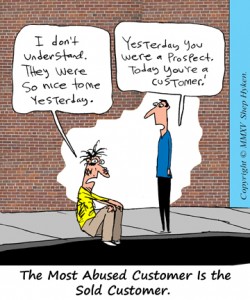 Customer Service Strategy
Customer Service Strategy
Years ago, when I was just starting to speak and consult on customer service, my friend Dr. Larry Baker shared this concept with me. Now the word abused may be a bit strong, but his point was well taken. For some customers, the pre-purchase experience is better than the post-purchase experience.
My belief is that the customer service starts and the experience begins the moment the customer just thinks about doing business with you. Customer service isn’t something that happens after the sale, it is also how the customer is treated leading up to the sale. And once it starts, it continues through the entire life of the relationship you have with that customer, which hopefully is for a very long time.
Recently I had the pleasure of experiencing Joey Coleman present a speech on the First 100 Days. This refers to the first 100 days after a customer pays for whatever you sell. Once the customer buys from you, until the customer gets or uses the product or service you sell, is the time the buyer may have second thoughts, or worse get buyer’s remorse. This is where the customer may potentially feel abused or neglected.
For example, you buy something on a website and it takes several days or longer before your order arrives. Or, you sign a contract to build a home, yet it may be months before any construction begins, let alone actually moving into the home. Or after months of consideration, you sign an agreement with a consultant, but the project doesn’t begin for 30 days.
Coleman’s idea is that the best opportunity for a loyal customer comes in that first 100 days. His entire presentation was about managing just those 100 days. Of course, you need to manage the long term experience, but those first 100 days are where you have your best opportunity to earn loyalty.
In the customer journey map there are many touch points. These are the places where customers interact with your employees. The idea of managing the 100 days is to create additional touch points, which further enhance the experience. This is proactive customer service.
Let’s use a hotel as an example. Typically, you make a reservation, receive the confirmation, show up, go about your business, and check out. If the stay is pleasant and the hotel staff takes care of you, you’ll probably come back. However, there may be a way of enhancing the guest experience that creates a stronger bond and raises the likelihood the guest will come back. Imagine this scenario:
You may make your reservation a month, or even longer, ahead of your stay. Within moments of making the reservation, you receive an email that confirms the details. That’s expected and a good start.
Then, just a two days later, someone from the hotel calls you to ask you if you have any special preferences, allergies, or anything else that the hotel may want to know to enhance your experience with them.
Two weeks from the date of your arrival you get another call from the hotel. This time it is the concierge calling to ask if you need any restaurant reservations or have any other needs he or she can help with.
Finally, you arrive and check in. You are warmly greeted. Your requests and needs have been taken care of, and just a few minutes after you are in the room the person who checked you in calls to make sure you’re happy with your room.
Two days after your stay you get a call from a hotel staffer thanking you and asking for feedback.
You get the idea. This type of customer service and experience strategy will work with any type of business. Take your already great customer service up a level by adding intentional and additional interactions that confirm in your customer’s mind that he or she made the right decision to do business with you.
This article was syndicated from Business 2 Community: The Most Abused Customer is the Sold Customer
More Sales & Marketing articles from Business 2 Community:




